
Station Name: DAGGONS ROADDaggons Road Station Gallery 2:
Summer 1964 - Summer 1964 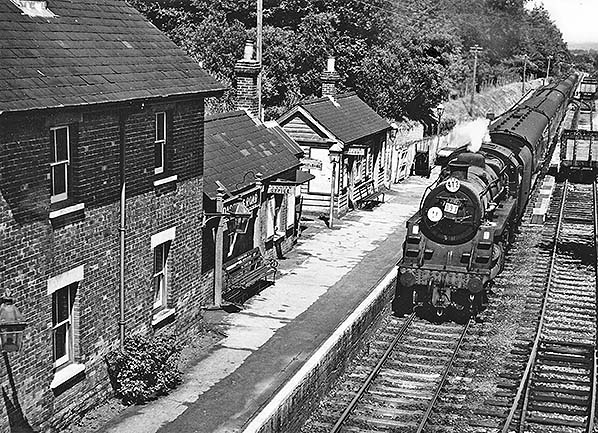
Sometime during the last decade prior to closure an unidentified BR Standard Class 4 2-6-0 passes Daggons Road. The Southern Region's share of this 115-strong class generally had the larger BR1B tender as seen here. The headcode disc positions indicated Salisbury to Bournemouth West via Wimborne, or vice versa, but was also carried by through trains using this route and not necessarily serving Bournemouth West. This is one such train, as indicated by the additional regalia attached to the smokebox door. A number of these trains operated on summer Saturdays between Cardiff or Swansea to destinations in the Bournemouth and New Forest area. The photograph shows Daggons Road station to have been in something of a time warp, a not uncommon situation with rural stations at that time. Only the running-in board shows any hint of modernity while all other signs that are visible have long since seen better days. The platform was oil lit and would remain so until closure. The darker section of wall on the station house is merely a shadow, the photograph being taken when the sun was almost directly overhead. On the right, what had been a single-ended siding, known as the Down Siding, had been converted to a loop, a passing loop according to some sources, in 1904. No doubt of some use when goods trains were operating, the loop doubtful saw much use for crossing passenger trains, if indeed that was the intention, as Daggons Road only ever possessed one platform. As the photograph suggests the loop saw more use as a double-ended siding, at least during later years, this being further evidenced by the provision of a walkway for staff, between running line and loop, covering point rodding. Daggons Road signal box, a small almost hut-like affair, stood out of view to the right adjacent to where the point rodding passes beneath the track. The box had been downgraded to ground frame status in 1903 and was never a Block Post. After 1903 only shunt signals were provided, despite the OS six inch map published in 1911 suggesting to the contrary but this map would have been surveyed some years previously. The points at bottom right led only to a short headshunt, in effect trap points. There was a longer headshunt at the other end of the loop, upon which in this view some mineral wagons are stabled. Not obvious in this photograph due to the presence of the train, points, facing in the Up (away from the camera) direction, connected to further sidings on the west side of the station (left). There was a dock behind the platform, to the left of the first two carriages, while another siding served a brick and pottery works located roughly behind where the mature trees can be seen.
Photo received from Andrew Bibby 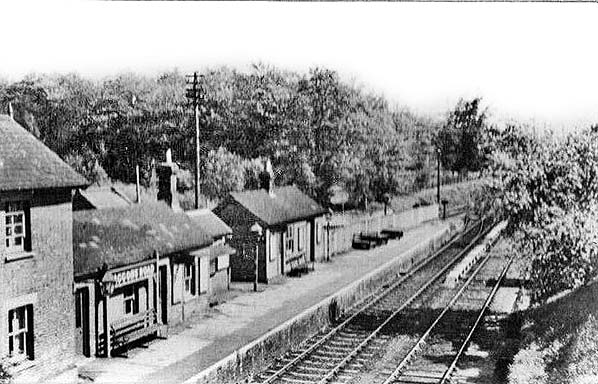 Daggons Road station looking north west fromn the bridge circa late 1950s. Little has changes since the turn of the century apart from the running-in board which is no longer mounted on the roof of the ticket office.
Photo from John Mann collection 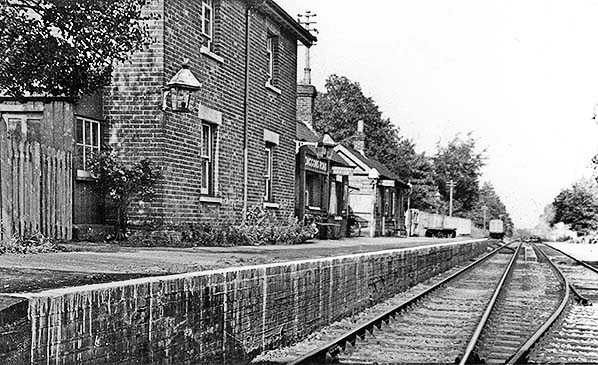
A view of Dagons Road station looking north west from the track circa late 1950s. A half hearted attempt to brighten the station up with flowers is note. The booking office is located to the right of the running-in board. The gents' toilet is between the two single storey buildings, The furthr building is the ladies' waiting room.
Photo
from John Mann collection
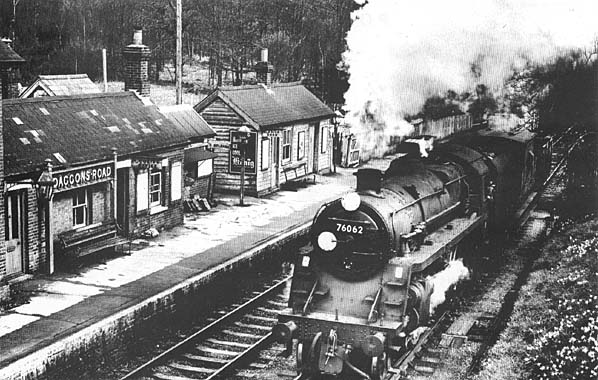 Sometime during the final decade of the line's life BR Standard Class 4 2-6-0 No.76062 is involved in goods shunting, probably coal wagons, at Daggons Road. By comparing this with earlier views it will be seen that very little had changed on the station over the years, the most obvious change involving the relocation of the running-in board. Like all the BR Standard steam locomotives, No.76062 had a dismally short career. She was new to traffic in 1955 and withdrawn from service ten years later. Her entire career was spent on the Southern Region and she was scrapped in 1966 by Cashmore, Newport, South Wales. Sometime during the final decade of the line's life BR Standard Class 4 2-6-0 No.76062 is involved in goods shunting, probably coal wagons, at Daggons Road. By comparing this with earlier views it will be seen that very little had changed on the station over the years, the most obvious change involving the relocation of the running-in board. Like all the BR Standard steam locomotives, No.76062 had a dismally short career. She was new to traffic in 1955 and withdrawn from service ten years later. Her entire career was spent on the Southern Region and she was scrapped in 1966 by Cashmore, Newport, South Wales.Photo received from Neil Lambourne 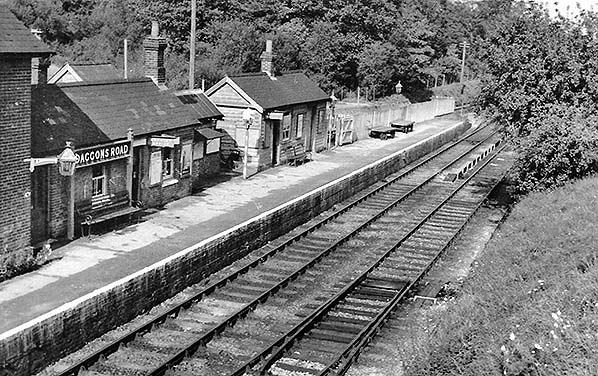
A clear view of the station buildings at Daggons Road circa early 1960s. The two storey station house is on the left adjacent to the booking office. The smaller building is the gents' toilet and beyond it the ladies waiting room and toilet. Two luggage trollys are seen at the end of the platform. A siding can just be made out running behind the platform. The brickworks and pottery had closed by this time but the siding was retained for railway use.
Photo from John Mann collection (road_old16.jpg) In July 1962 an unidentified U Class 2-6-0 pauses at Daggons Road with a Salisbury-bound service. The train is a Bulleid 3-set, all vehicles being of the later design with deeper sliding vents. The U Class locomotives are given a very brief historical description in another caption. On the left we are afforded a decent view of the steep access road to the coal and, at one time, cattle facilities along with the north-east side of the signal box or, more specifically by this time, the ground frame. In the days of horse-drawn road vehicles and indeed the days of early motor vehicles, quite how loaded vehicles reached the road over the bridge is quite bemusing. A study of various maps suggests there was no other road access to this side of the railway, not is any barrow crossing over the tracks known to have ever existed. On the right it can be seen that the goods siding now only serves the dock behind the platform; the siding which served the brick and pottery works had gone by 1959 according to Ordnance Survey maps. The siding curved round alongside the shored-up wall and it would appear its former course is already becoming overgrown.
Photo from John Mann collection 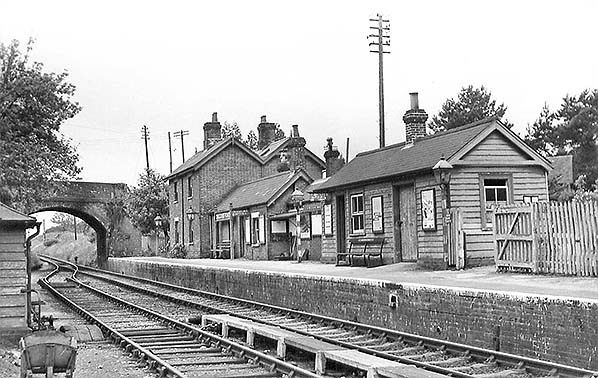 A view of the station buildings at Daggons Road from the west side goods yard in July 1962. Note the lamp standard in front of the gent's toilet painted in alternate black and white sections. This was a wartime embellishment to make the standards more visible during the blackout. A building with a hipped roof is sen behind the ladies waiting room, its purpose is unknown but it may have been a goods office and lockup. A view of the station buildings at Daggons Road from the west side goods yard in July 1962. Note the lamp standard in front of the gent's toilet painted in alternate black and white sections. This was a wartime embellishment to make the standards more visible during the blackout. A building with a hipped roof is sen behind the ladies waiting room, its purpose is unknown but it may have been a goods office and lockup.Photo from John Mann collection 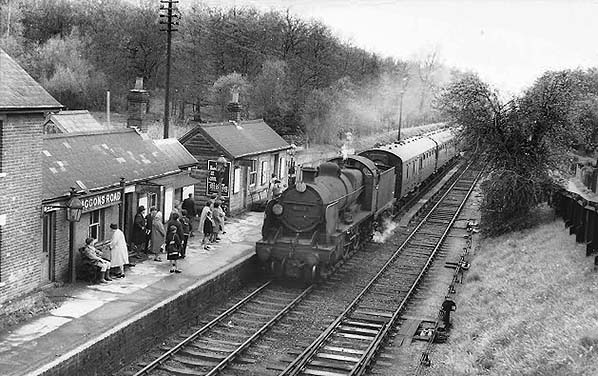 With High Wood in the background, business would appear to be brisk for the approaching local service which is probably destined for Bournemouth West. The tree, as always, obscures the signal box (long since reduced to ground frame status) and the rear of the train which is formed of BR Mk1 stock and likely a 3-set. The locomotive is ex-Southern Railway U Class 2-6-0 BR number 31792. These locomotives gained the nickname 'U-Boats' after the Kriegsmarine 'Unterseeboot', or submarine in English. The U Class had an interesting history in that the first twenty of the fifty-strong class were rebuilds of the infamous South Eastern & Chatham Railway K Class 2-6-4Ts, better known as the 'River Class'. Both classes were designed by Richard Maunsell. No.31792 was one of the rebuilds. At the time of conversion, at Eastleigh in July 1928, she was No.A792 and later became Southern Railway No.1792 before ultimately acquiring her BR number. In 'River' form she had been built during 1925 by Armstrong Whitworth, new ex works during May of that year, and named 'River Arun'. She was withdrawn in September 1964 and subsequently scrapped. Four members of the U Class have, however, survived into preservation. One of them, BR No.31806, being a 'River' rebuild and originally named 'River Torridge'. The origin of the "U-Boat" nickname is unclear. Some sources suggest it came merely from the 'U' class designation, others from the fact they could be seen almost anywhere on the Southern Railway/Region rather like the German submarines which in wartime could and did lurk almost anywhere in British waters. The truth is probably a mix of both. The U Class locomotives, however, were not able to fire torpedos and neither could they operate on or under water.
Photofrom James Lake collection 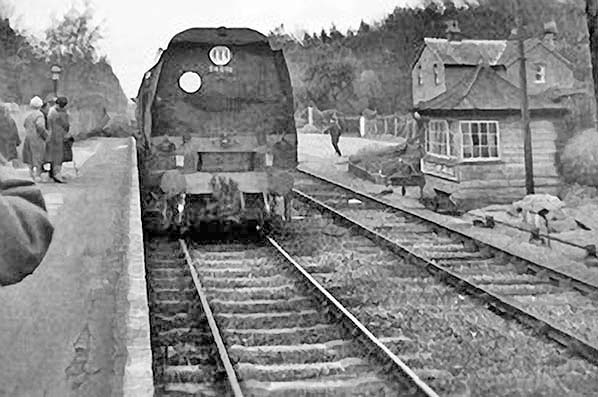 Bulleid Light Pacific No.34092 'City of Wells' arrives at Daggons Road with a service in the Bournemouth direction. The period will be between May 1961 and closure. The rather quaint signal box, long since demoted to ground frame status, is visible on the right. A few passengers are waiting. The locomotive is in what OVS Bulleid referred to as 'Air Smoothed' form. giving rise to the almost universally used nickname 'Spam Cans'. They had a number of typically Bulleid pecularities and many were rebuilt into conventional form, but 'City of Wells' was among several to retain original form. Withdrawn in November 1964 from Salisbury shed, she has survived into preservation. 'Pacific' refers to the 4-6-2 wheel arrangement and although these locomotives were not rare on the Salisbury & Dorset Junction line they were by no means an everyday sight. Far more common were 4-4-0 and 2-6-0 types, as other photographs illustrate.
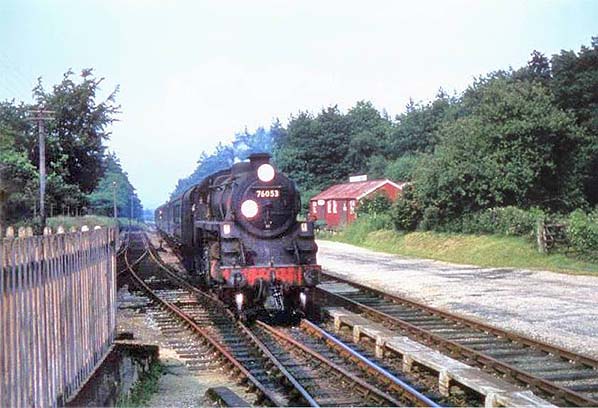 BR Standard Class 4 2-6-0 No.76053 approaches Daggons Road with a Down passenger train. The period will be between May 1960 and closure, when this locomotive was shedded at Salisbury. We are offered a partial view of the rather limited goods facilities at Daggons Road. Good trains had to enter the headshunt and reverse wagons into the dock behind the fence on the left. A second siding had served the brick and pottery works, which stood well out of view to the left, but this had been lifted by this time. The Down side loop, apparently used mainly as a coal siding, is out of view behind and right of the camera. At one time there were also cattle pens located on the right. No.76053 was withdrawn, from Guildford shed, and scrapped in 1967, not quite surviving long enough to witness the end of steam on the Southern Region. The roadway on the right was accessed via a quite steep slope from the east side of the bridge. Today a narrow road named Station Yard roughly follows its course.
Photo from Nel Long collection 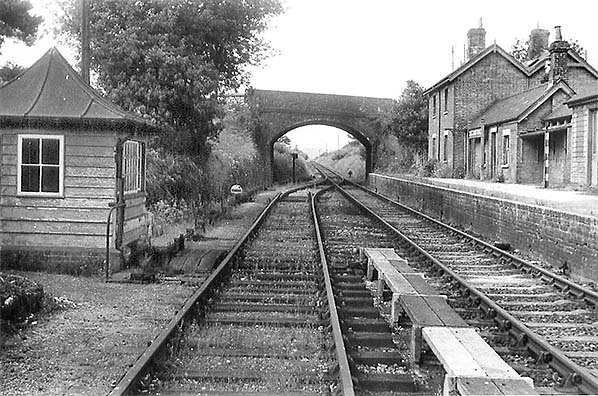 Daggons Road station looking south-west in July 1964, two months after closure to all traffic. The track remains largely clear of undergrowth. There is some undergrowth at the south end of the platform beyond the station house. Although the runnin-in board remains in place and can still be seen in the garden to ths day all other signs and poster boaqrds have been removed as has all station lighting. Station buildings remain largely intact as does the small signal box.
Photo from John Mann collection 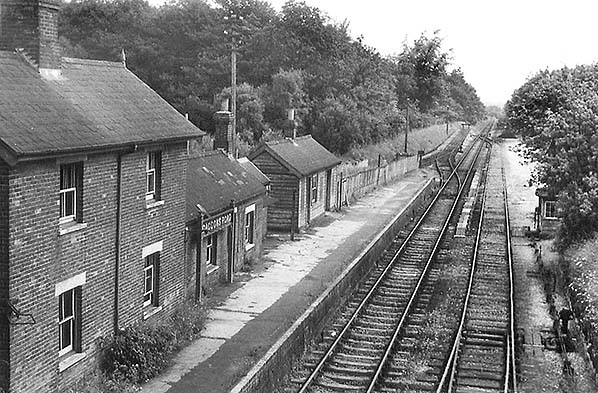 Daggons Road station looking north-east from the road bridge shortly after closure.
Photo from John Mann collection Click here for Daggons Road Station Gallery 3:
Summer 1964 - December 2019
 Home Page Home Page
|
